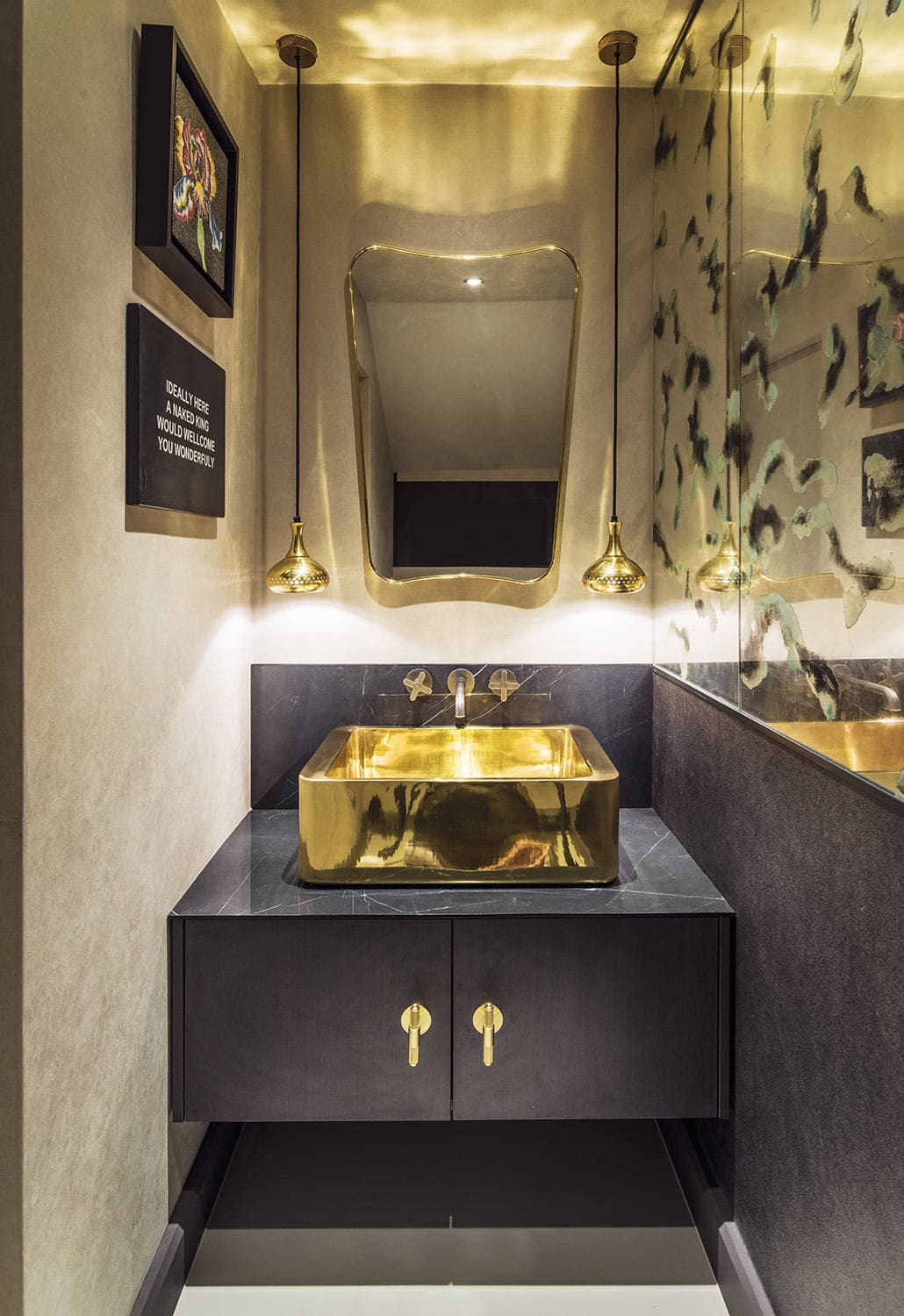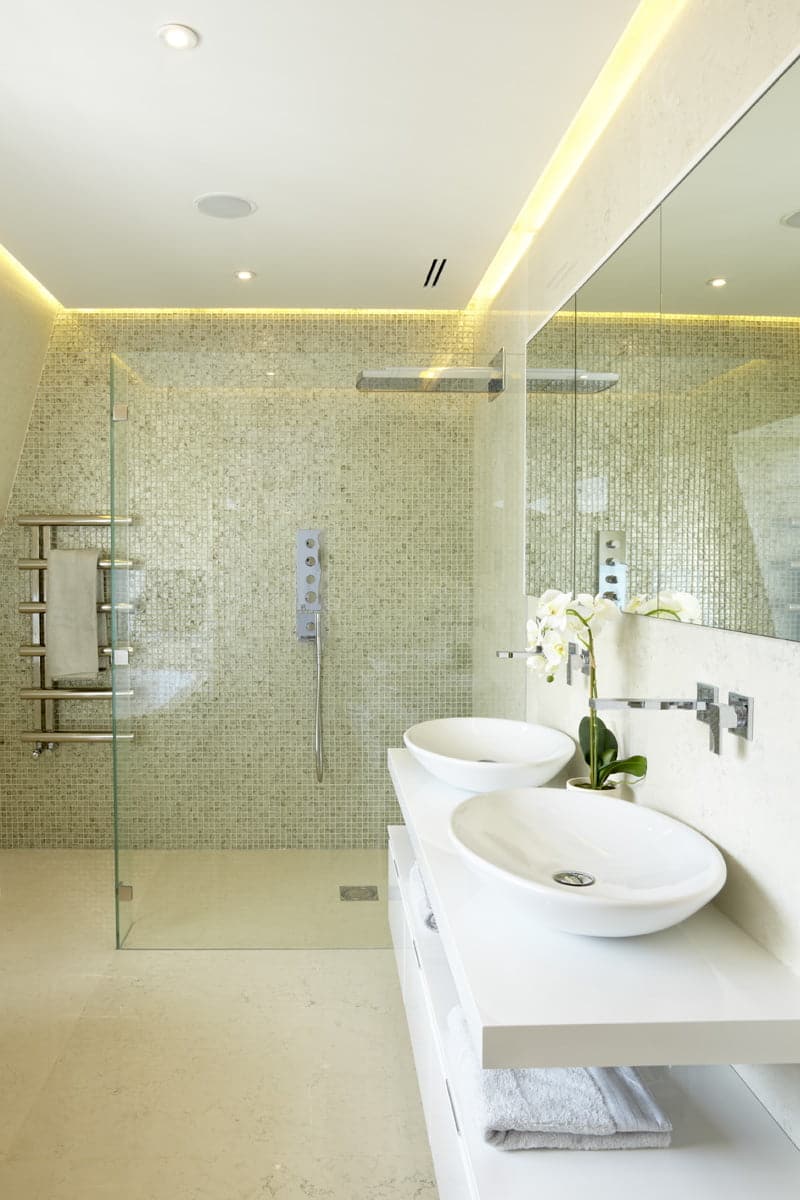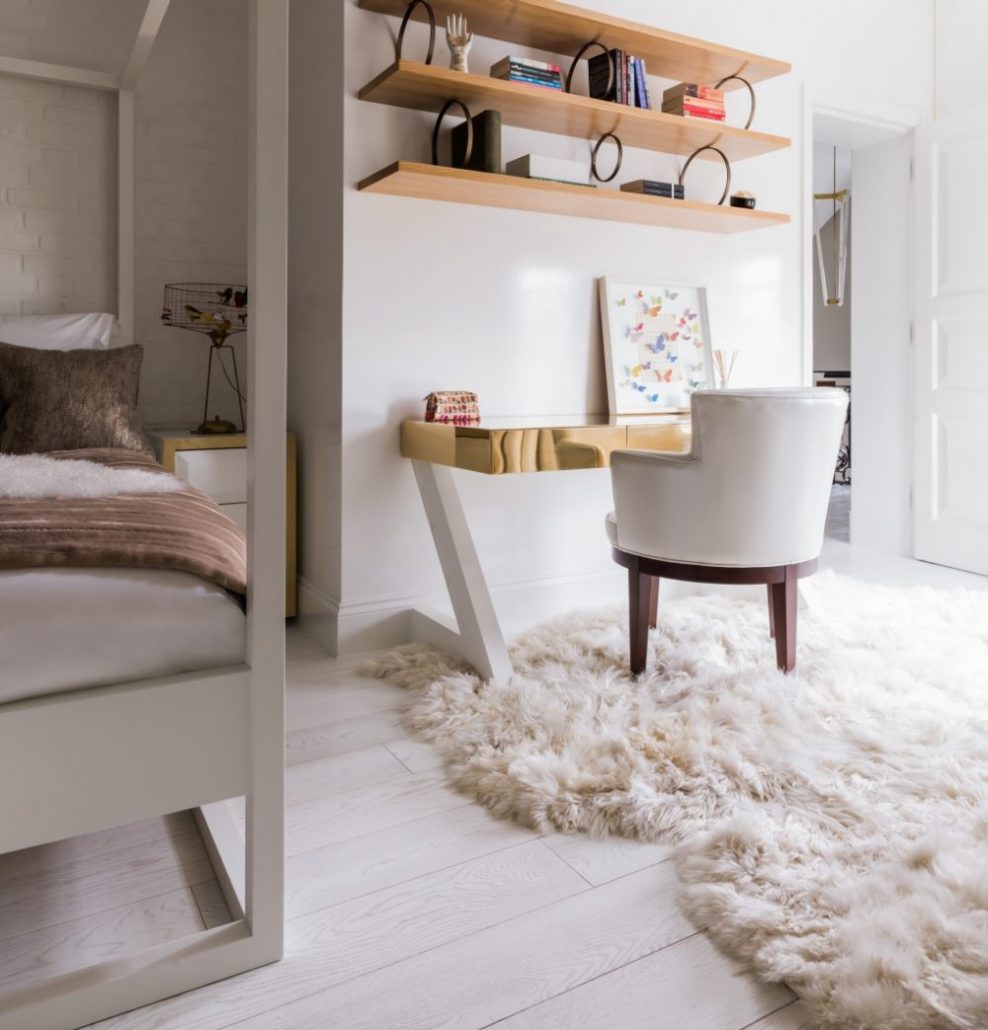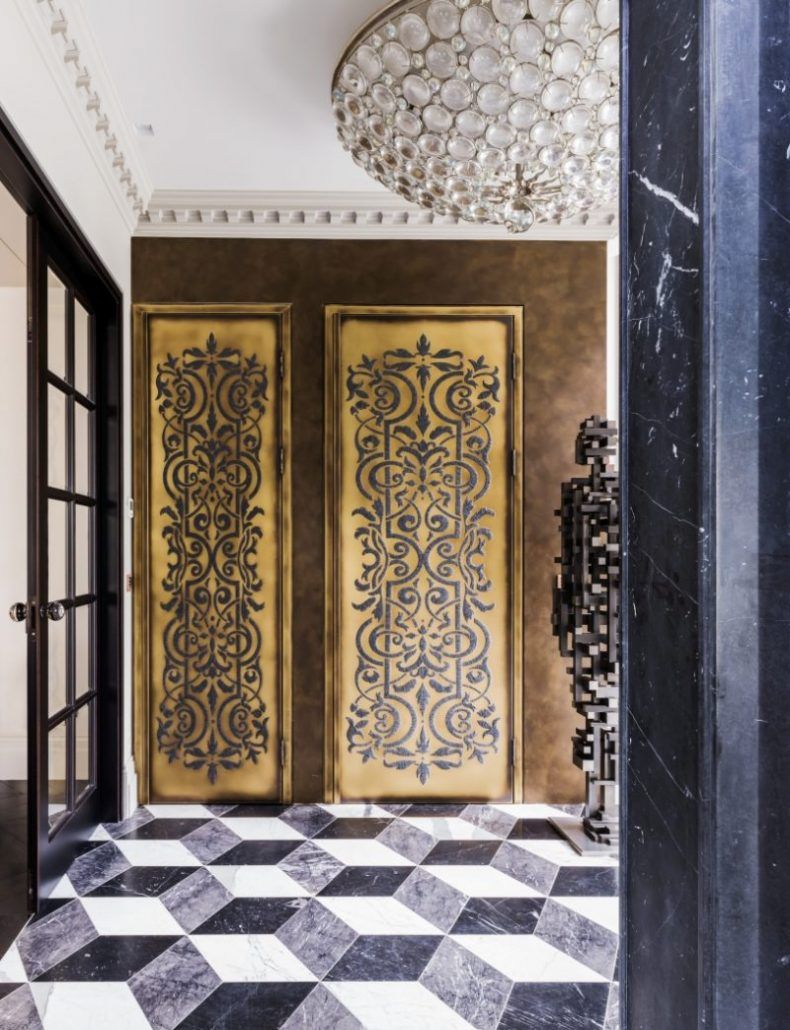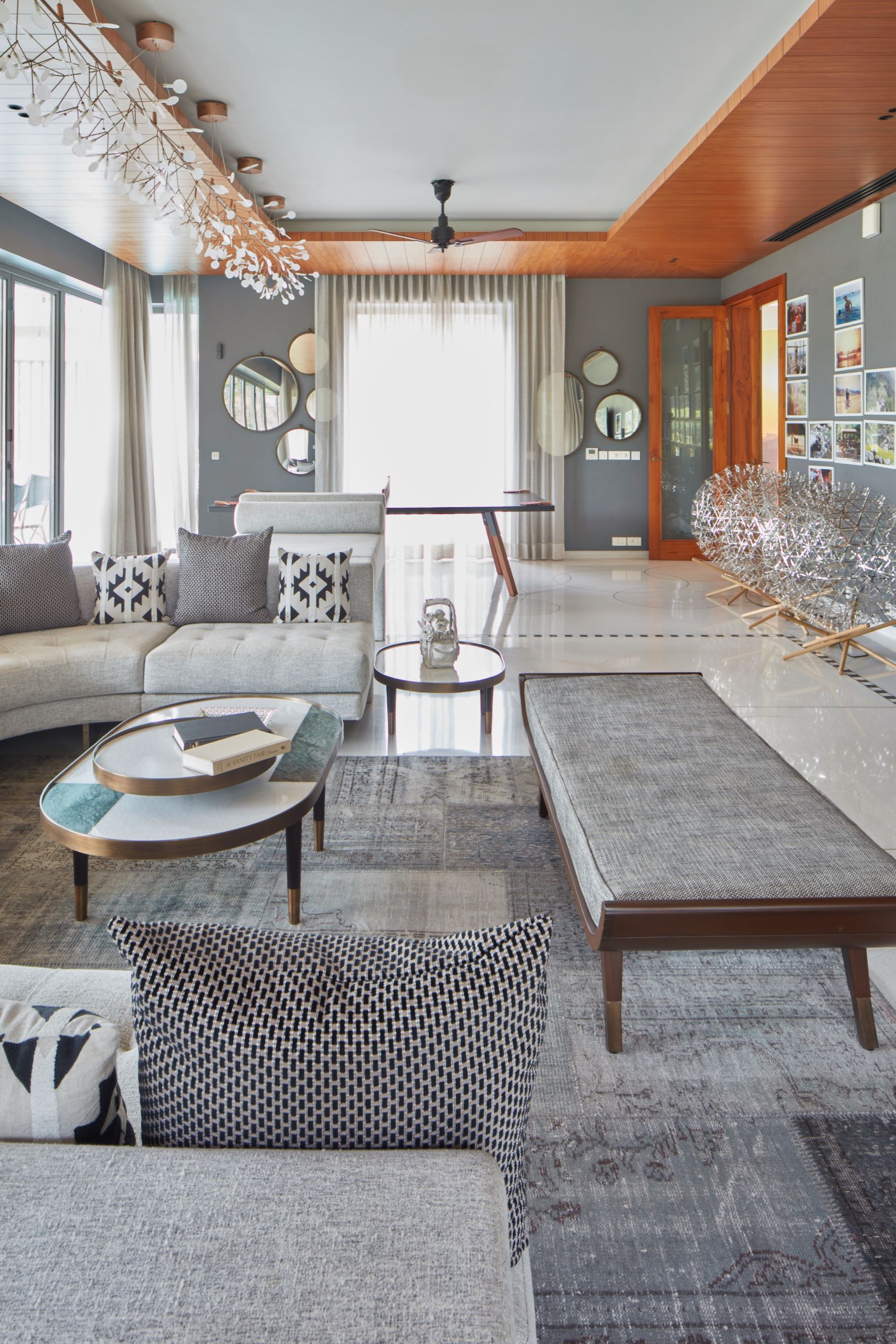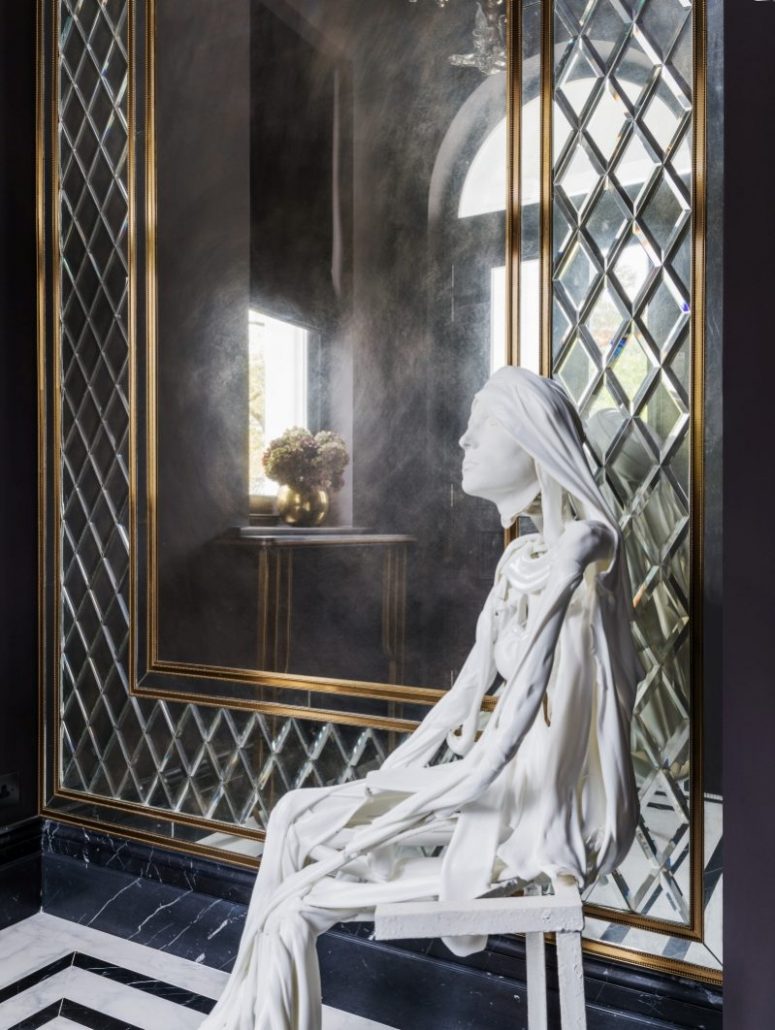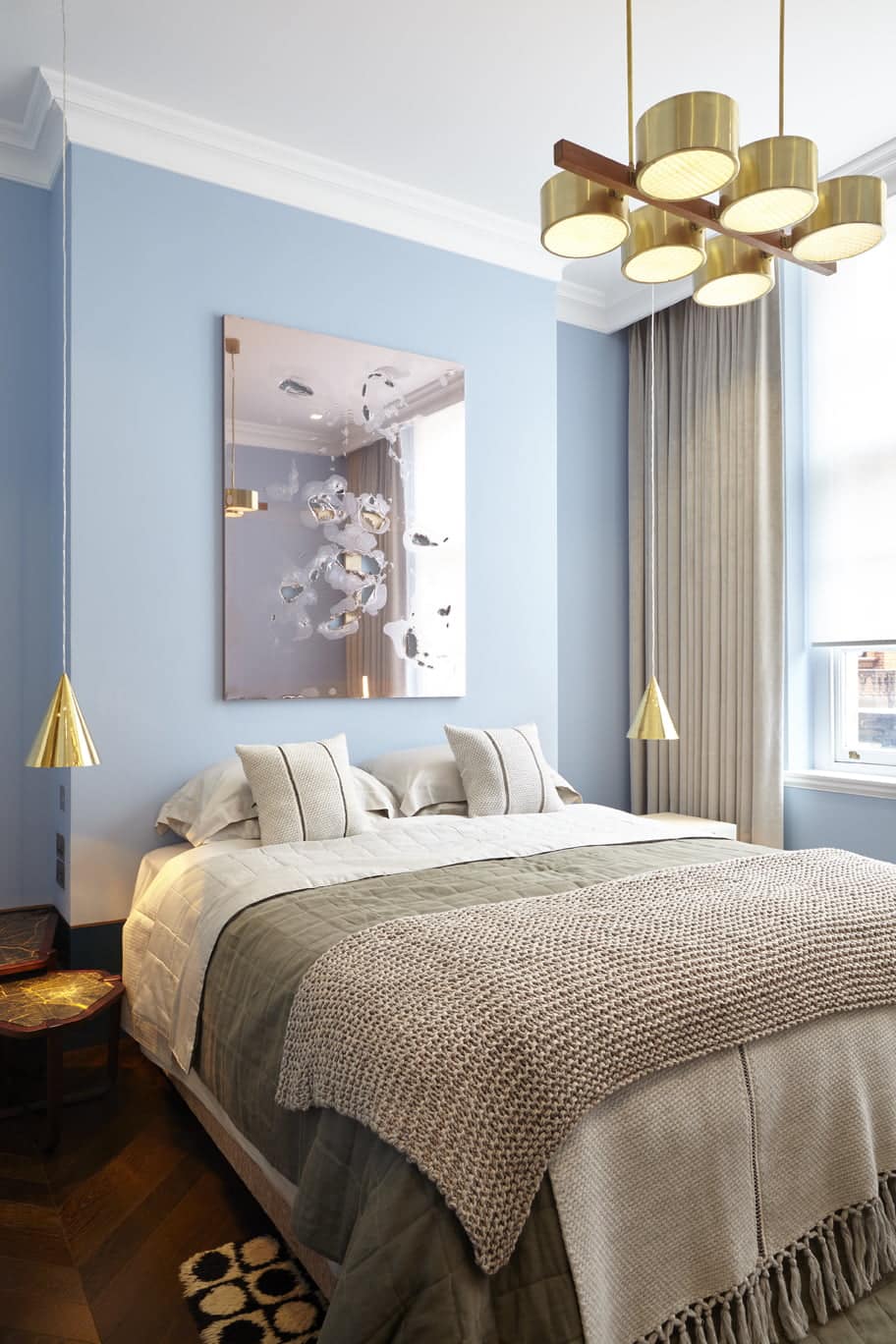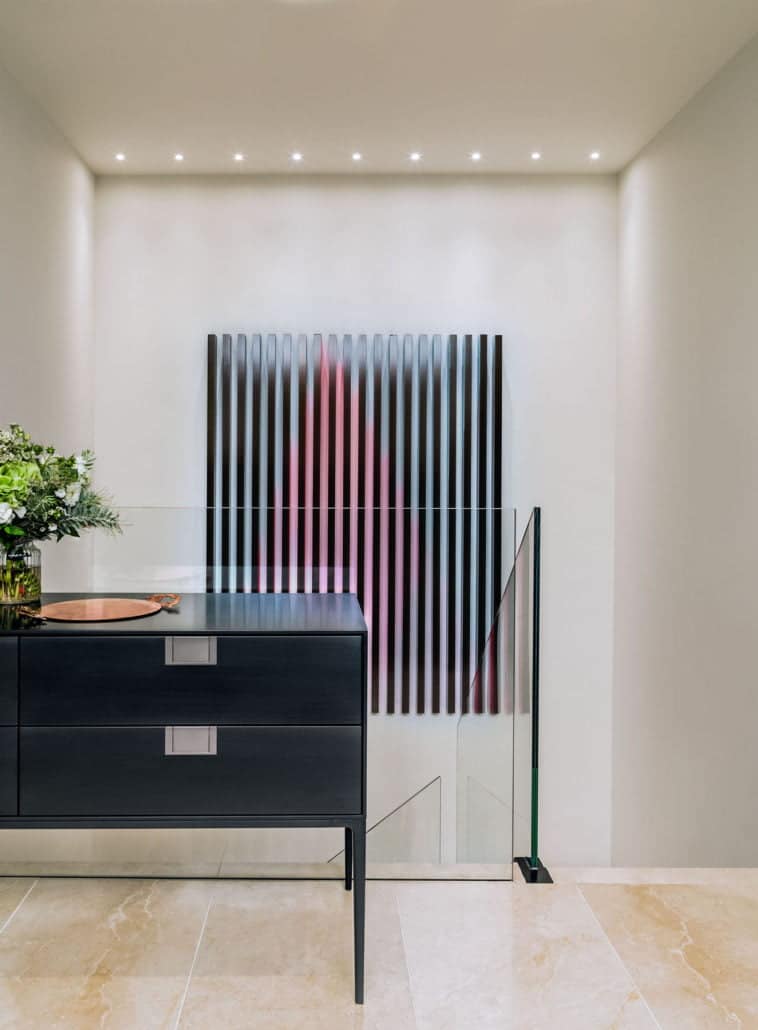Dark Bathroom Design Ideas
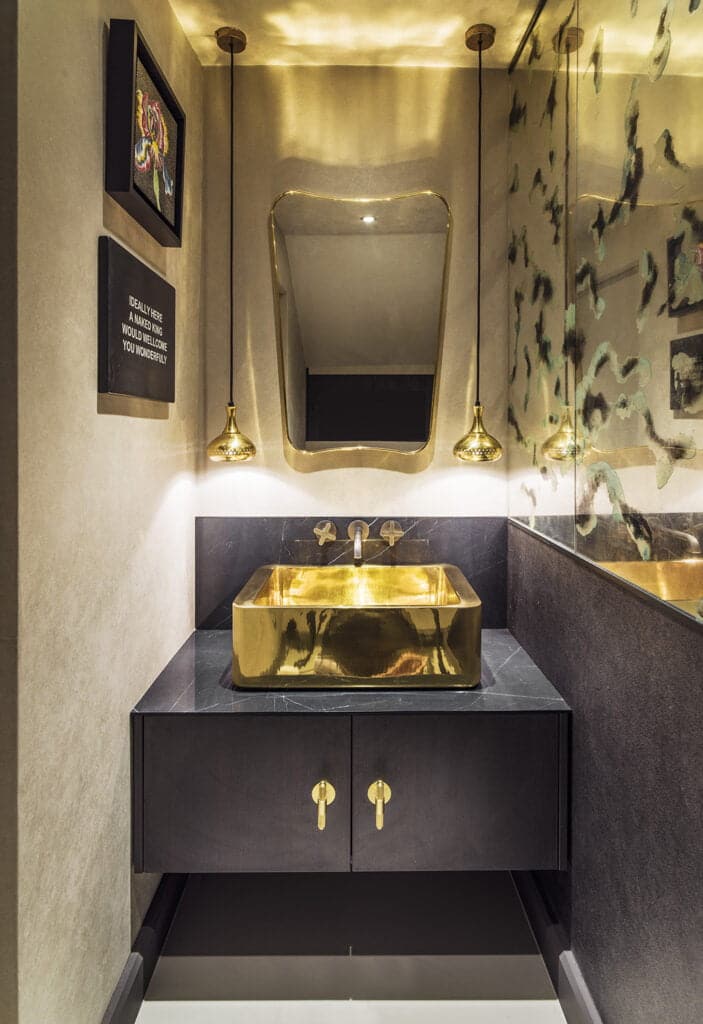
When you’re designing bathrooms, you have free rein to create a luxurious and decadent environment, yet many people automatically opt for white and neutral shades. Fortunately, we’re seeing a whole new trend of dark bathrooms emerging and we couldn’t be happier! When you stray from the standard bathroom designs you see out there, you’ll soon realise why doing something a little different with the space can deliver such sublime results.
To plan your own bathroom redesign, refresh, or renovation, take a look at these nine ways to incorporate dark bathroom ideas into your plans:
1. Use More Than One Colour
A single dark colour can feel too overpowering but incorporating two colours into the theme instantly makes the room feel more spacious. Interestingly, you don’t need to pair a dark colour with a light shade to achieve this effect. Instead, choose two dark colours that share the same tone to complement each other. With grey-blue paint on the upper section of the walls and deep grey tiles on the lower sections, for example, you can add visual interest and maintain a dark, dramatic style.
2. Add Brightness with Metallics
A dark bathroom needn’t feel dull or drab, particularly if you use metallic accessories to add brightness to the space. The lustre and luminosity of metallics will ensure the accessories you choose are eye-catching and they’ll serve to make the room feel lighter too. For cooler tones, opt for silver, nickel, or platinum but, if you favour a warm feel, choose bronze, gold, or copper.
Remember – metallics aren’t just ideal for accessories, like mirrors, lighting, and decorative pieces; they’re also a great option for bathroom fixtures and fittings. A brushed metal countertop basin or a polished copper bath can act as a statement feature while making dark bathrooms pop.
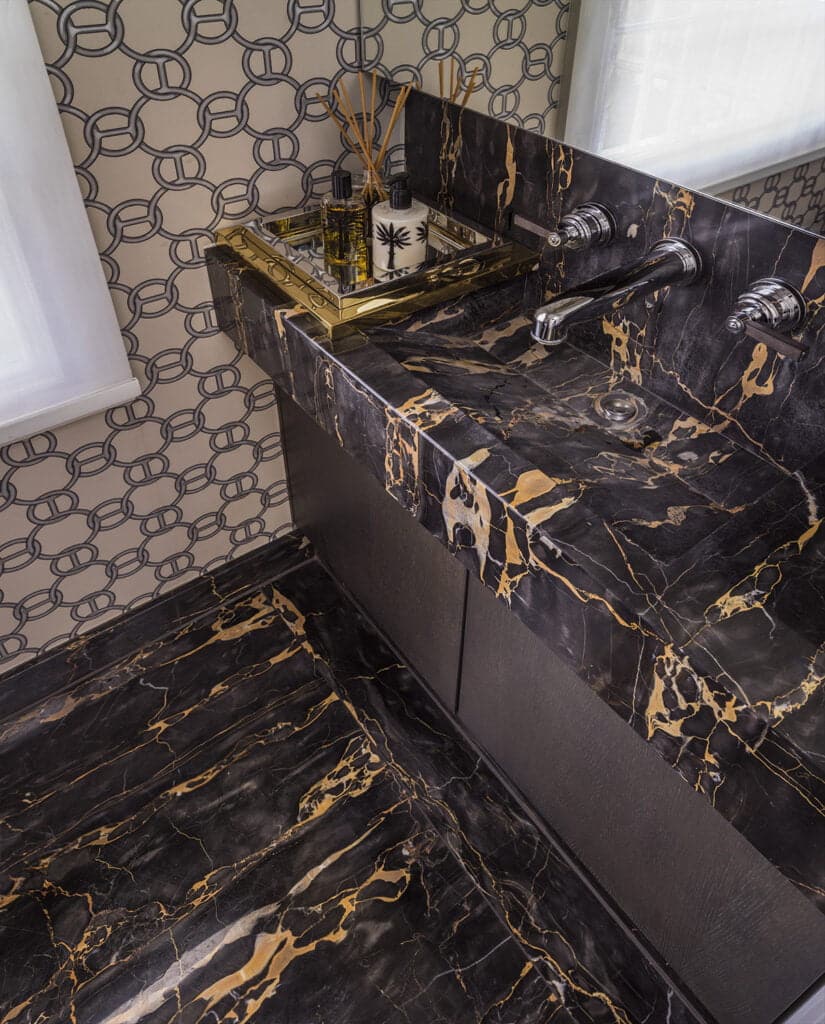
3. Incorporate Bold Patterns
Relying solely on solid colours can be uninspiring, so why not add visual interest to your space with bold patterns? From tiles and wallpaper to blinds and screens, there are a variety of ways you can inject patterns into a dark bathroom. Whether you complement a dark palette with lighter tones or stick to moody shades, a pattern will lift the atmosphere and can add a sense of fun, glamour, or relaxation.
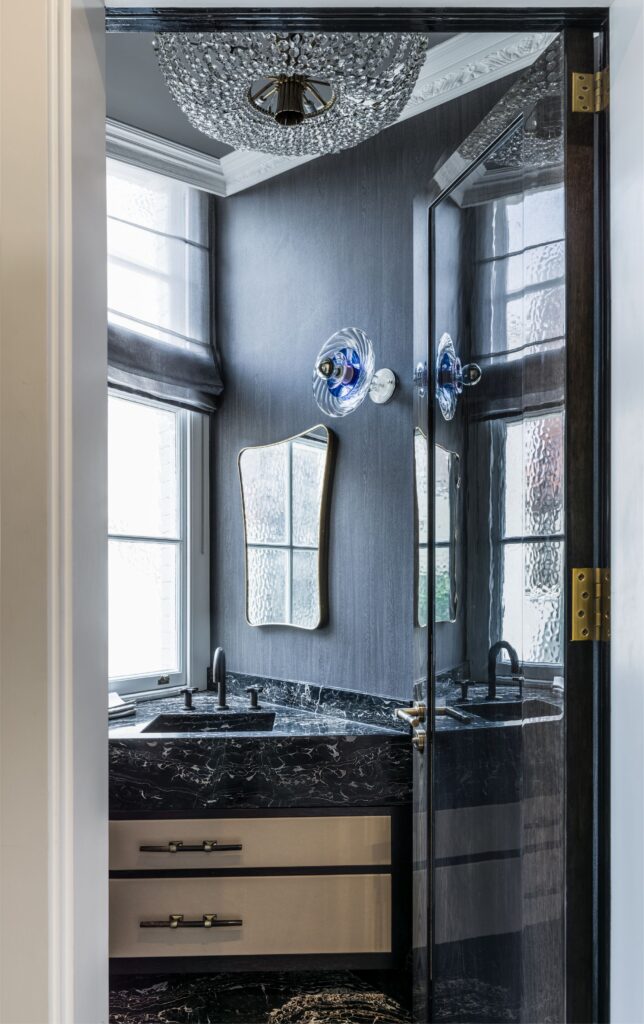
4. Maximise Natural Light
Every room can benefit from an abundance of natural light, but this isn’t always available in bathrooms. To maximise privacy, most bathrooms have small windows or are fitted with opaque glass that prevents natural light from filtering through and illuminating the room. However, you can increase the amount of natural light by using mirrors strategically.
Mirrors obviously have a functional purpose, but don’t select a piece based solely on its use. Instead, choose a large mirror that will reflect a large amount of light and illuminate the room effectively. Similarly, place the mirror in a location that will allow it to reflect a significant amount of natural light from any windows that are present.
5. Use Marble for a Spa-Like Environment
If you want to create a sense of luxury in a dark bathroom, opt for marble features and accessories. A marble countertop can be a great alternative to a sink unit, for example, while marble effect tiles will break up dark colours and add visual interest to your design.
Marble is commonly associated with elegance and decadence, which is why it it’s the perfect addition to a bathroom environment. You can create a relaxation, spa-like feel in any home when you use marble to add a touch of opulence. What’s more – black, grey, or green marble will complement a dark colour scheme, while cream, natural of white will add contrast.
6. Add Natural Materials
When it comes to bathroom furniture and accessories, natural materials can enhance your design and optimise your well-being. By surrounding yourself with natural materials, like wood and cotton, you can increase the sustainability of your home and add textural depth to your design. Terracotta, wood, stone, and seagrass are all popular options, but make sure that any pieces you choose are designed to withstand the increased moisture and humidity that’s present in a bathroom.
7. Use Layered Lighting
Lighting is important in any room and the bathroom is no different. Why settle for a single lighting option when you can use layered lighting to create a multitude of different environments? Spotlights on the ceiling can provide a clean, bright feel, for example, while soft, recessed lighting offers a more relaxing feel that’s perfect when you’re enjoying a long soak in the tub. Again, make sure that the lighting you choose is designed for bathrooms and meets the regulatory standards for high-moisture areas.
8. Complement Dark Tones with Accent Colours
If you love the style of a dark bathroom but you’re wary of going too dark, use an accent colour to temper the effect. Bright colours look spectacular with dark greys, for example, while deep, dusky pinks, light beige or teal can look sensational with black. If in doubt, pair dark colours, like navy blue or emerald green, with white accents for a clean, crisp and stylish feel.
9. Add Patterns with Tiles
Incorporating a pattern into your bathroom draws the eye and creates a feature out of a functional element of your design. However, you needn’t choose tiles and wallpaper that’s adorned with a pattern to achieve the effect. Instead, choose a tiling application that offers an interesting pattern and turn it into a feature in your new, dark bathroom. A running bond or offset layout gives a clean and classic look, for example, while herringbone tiles will add a sense of traditional elegance. Alternatively, try a stacked vertical layout if you want to emphasise the height of the room, or a brickwork pattern if you want to achieve a more modern, industrial feel.
Designing Dark Bathrooms
While using a dark colour palette in bathrooms can feel nerve-racking at first, it’s an easy way to add sophistication and glamour to a functional space. From cool jet black or eggplant to navy blue, burgundy or forest green, there are endless shades, tones and hues that can be used to create a dark, dramatic, and delectable bathroom.
LED Interior Lighting
Lighting can transform any environment, which is why it is such a critical component of interior design. Whether you’re renovating a property, upgrading a room, or planning an indoor-outdoor space for summer fun, the lighting you choose can increase the functionality of the space, optimise its health benefits and enhance the atmosphere.
When it comes to interior lighting, people typically focus on fixtures and fittings that can complement a room’s design. However, it’s important not to overlook the type of lights you’re using. Here, we take a closer look at LED lighting, what it is, what benefits it offers and how it can be used to enhance your interior design…
What Is LED Lighting?
Light emitting diodes, or LEDs, generate visible light via an electrical current passing through a microchip. As LEDs are small in size, they offer a range of design possibilities. You’ll find LED bulbs that mimic the appearance of traditional incandescent bulbs and halogen bulbs, for example, but you’ll also discover LED strip lights, lighting tubes and lighting bars. With so many options on offer, it’s easy to see why LEDs have become a popular feature in interior design, but these aren’t the only advantages associated with this type of lighting.
What are the Benefits of LED Lighting?
LED lights can be used in homes, offices, warehouses, hotels, nightclubs and virtually any environment you can think of. With endless applications and variations, you can create custom lighting solutions to enhance any space. If you’re still not convinced, take a look at some of the benefits associated with LED lighting:
Energy Efficiency
LED lights use around 80-90% less energy than traditional incandescent bulbs and substantially less than halogen or fluorescent bulbs. As homeowners and employers become increasingly concerned about the sustainability of their premises, switching to LED bulbs can reduce energy consumption and make your interior more environmentally friendly.
Increased Lifespan
When you use LED lighting, you’ll find yourself changing the bulbs around your home or office much less frequently. On average, LED bulbs last for around 50,000-100,000 hours, which is 40 times longer than standard incandescent bulbs and 2-4 times as long as halogen or fluorescent bulbs.
High Colour Rendering Index
The colour rendering index of a bulb refers to its ability to showcase colours accurately. After all, when you’ve carefully selected a colour palette for your interior, you’ll want to ensure that it looks as good as it should in all lighting. As LEDs have a higher colour rendering index than other types of bulbs, you can ensure that the colours around your home and office are displayed perfectly when you use LEDs to illuminate the space.
Directional Lighting
Incandescent, halogen and fluorescent bulbs emit 360-degree light, which can be frustrating if you want to use lighting to enhance a particular interior design feature. In contrast, LED lights emit 180-degree light, which gives you greater control over the illumination and deliver seamless directional lighting.
Greater Control
Although numerous types of lights can be dimmed, most older-style lights can only be dimmed at particular light intervals. With LED lights, however, you can use them at any power percentage. This effectively means that you’ll have greater control over the lighting and be able to create the perfect ambience for the space.
Correlated Colour Temperature
The correlated colour temperature (CCT) of LED lights allows you to choose bulbs that are cooler or warmer in tone. For active spaces, like offices or gyms, cooler, bright lights are often needed, whereas softer and warmer tones may be preferable in relaxing spaces, like living rooms and bedrooms. Measured in Kelvins, you can choose cold, cool, neutral, and warm LED lights to adorn your interiors.
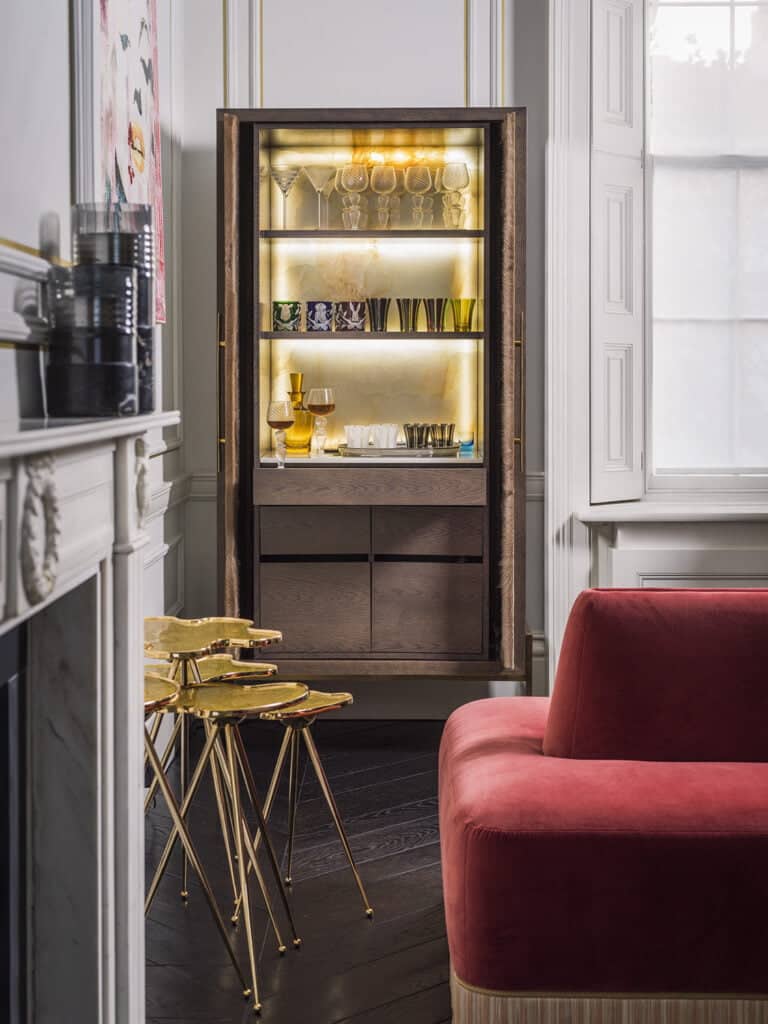
Using LED Lighting in Interior Design
Now you’ve got an insight into why LED lights are a first-choice solution amongst interior designers, take a look at how you can use LED lighting to enhance any space:
Showcase Features with LED Strips
LED strip lighting can be used to illuminate a specific area in a subtle yet noticeable way. If you want to showcase a particular feature, such as a drinks cabinet, carefully placed LED strip lights will draw your attention to the feature without being overpowering.
Use Mock Filaments for an Industrial Feel
Incandescent bulbs are well-suited to industrial interior design in terms of appearance, but you don’t have to settle for energy-zapping standard bulbs just to achieve your preferred look. Instead, choose LED bulbs with faux filaments that complement the industrial style but deliver all the benefits of LED lights.
Experiment with Lumens
Replacing incandescent bulbs with LED bulbs is one of the easiest ways to improve the energy efficiency of your home, but don’t necessarily go for a like-for-like swap. Lumens refers to the amount of light emitted, which equates to the brightness of the bulbs. An LED bulb with a 400 Lumen rating is equivalent to a 40W incandescent bulb, for example. However, experiment with LED bulbs with different Lumen ratings to discover which works best with your chosen lighting fixtures.
Install LED Artwork
Lighting isn’t just a functional element of a home or workspace; it is a design feature in itself. When you use LED artwork in your interior designs, you can illuminate the space in an eye-catching way and enhance the overall environment.
Choose Hidden Lighting for Maximum Impact
Feature lighting can be a fabulous addition but, in some interiors, a more minimalist feel is preferred. If so, take advantage of small-size LEDs to add hidden lighting to the space. Recessed LEDs or strip lighting on top of cupboards or kitchen units can deliver stylish illumination without the need for large fixtures and fittings, for example.
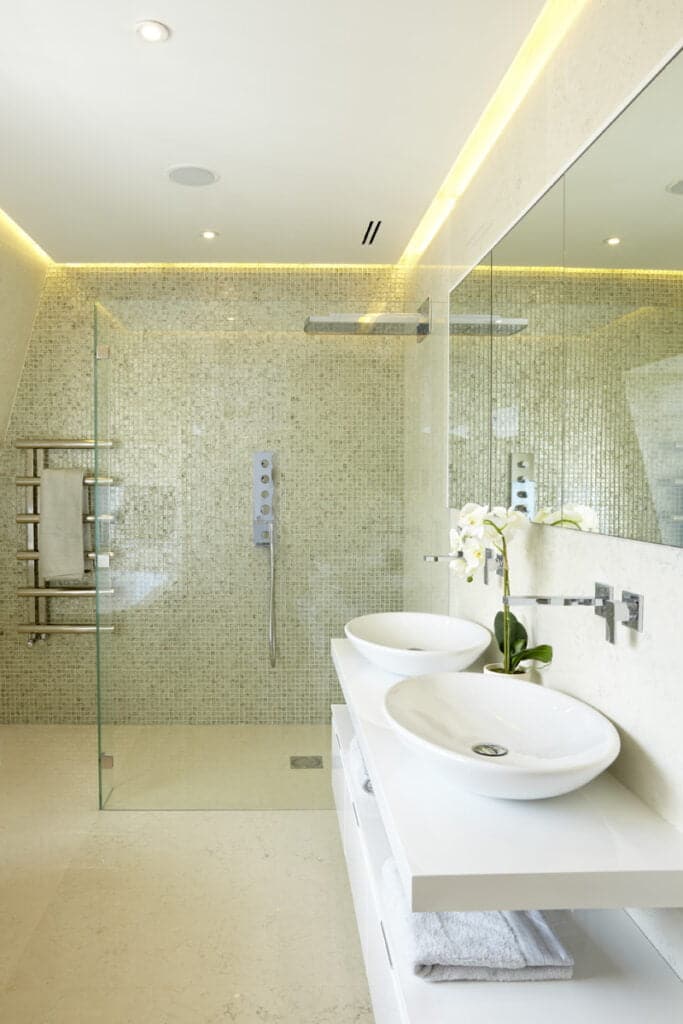
Illuminate Your Interiors Now
As LED lighting can be used in so many ways, it really can enhance any type of interior design. From classic styles to super-contemporary looks, you’ll find a range of LED lighting solutions that meet your needs. Whether you’re designing a bedroom, home office, bathroom or kitchen, LED lighting provides you with customisable design options that allow you to achieve any finish.
Create a Zen Space for the Home and Office
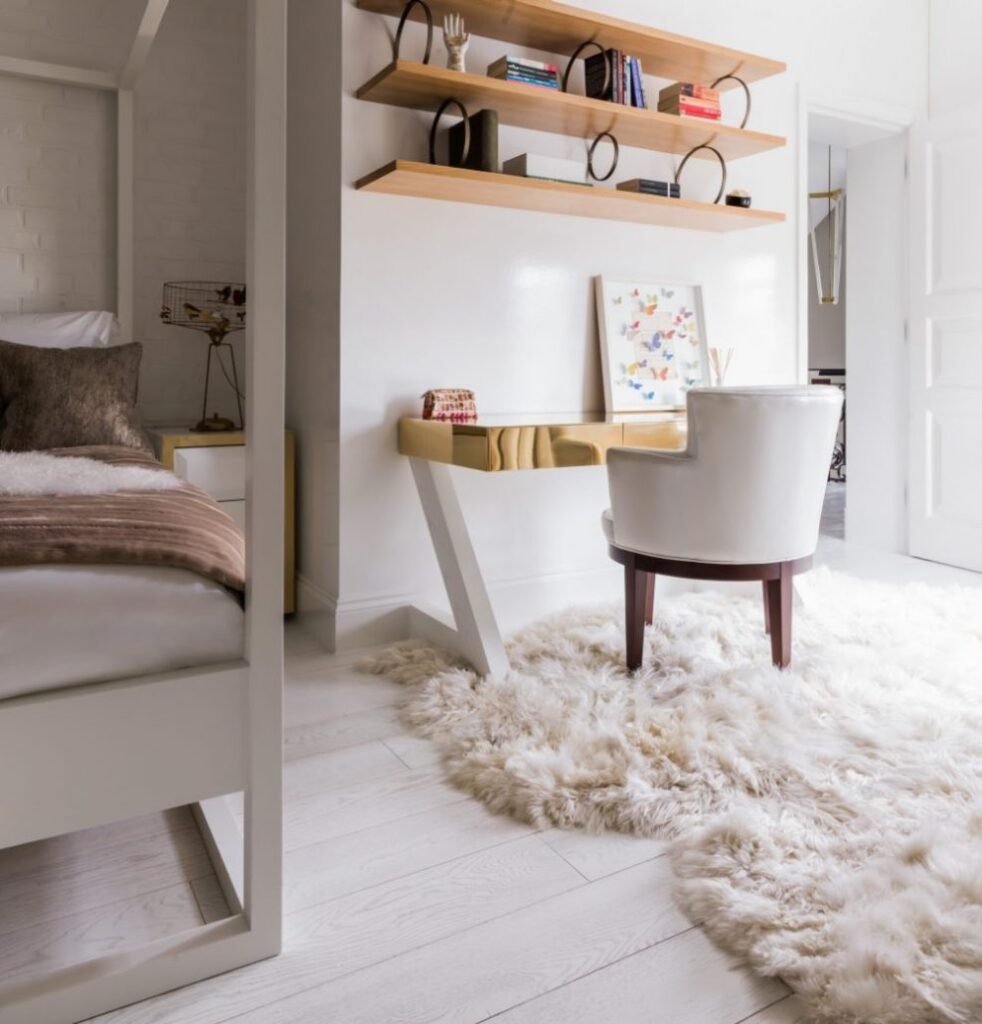
Prioritising wellness can enhance your physical and mental well-being, which is why it’s well worth incorporating a zen space into your home and office. By practising healthy habits on a daily basis, you can optimise every area of your life, manage stress more effectively and enjoy your surroundings more.
With the right environment, incorporating these healthy habits into your day-to-day routine becomes second nature and makes it much easier to integrate wellness into your lifestyle. To get started, take a look at these six tips for creating a zen space and maximising wellness:
1. Choose a Designated Space
If you want to create a wellness area at home, the first step is to choose a designated space. Perhaps you have a spare room that you want to transform into a zen space or maybe you’re converting a basement into a wellbeing zone. If so, you’ll have free rein to design a wellness room that meets your needs perfectly.
However, don’t be discouraged if you’re limited on space. With savvy interior design, you can integrate a zen space into an existing room. If you have an open plan living area, for example, you can add a wellness zone into the space or even safeguard a zen space in your home office or bedroom.
2. Consider the Purpose of the Space
Firstly, consider what you want to achieve and gain from your zen space. If you’re a yoga aficionado, having enough space to practise your asanas might be a top priority. For fans of mindfulness or meditation, a quiet space that allows you to embrace the present moment may be advantageous.
There are many ways to promote wellness, so avoid being too rigid when identifying the purpose of your zen space. Instead, make sure the space offers flexibility so that you can incorporate different wellness strategies into your routine.
If you’re adding a zen space into an existing room, you’ll need to consider the multi-purpose functionality of the space too. Trying to incorporate a wellness zone into an entertainment area could be tricky if you’re sharing your home with kids or teens, for example. Instead, choose an existing space that lends itself to quiet reflection, rather than bustling family life. A dining room or bedroom may be easier to align with a zen space than a busy kitchen or den, for example.
3. Choose a Calming Colour Palette
Colour psychology is a helpful way to plan a colour palette, particularly when you want a particular space to aid in relaxation and stress management. While many people assume that painting a zen space stark white is the way to go, this isn’t always the case. White can be cold and uninviting, so if you do want to embrace simple white décor, choose a shade that adds some warmth to the space.
Alternatively, use colour to emphasise the tranquil nature of the space. Green represents nature, for example, and can help you to reconnect with the great outdoors, while earth tones, like brown, tan, and terracotta can be fantastic for relaxation and grounding. For calming and anxiety release, cool blues are an excellent choice, while yellows will elevate your mood and add a sense of optimism to the space.
4. Design Flexible Lighting
Lighting is an important element in any space but it’s particularly relevant when you’re creating a zen space. Ideally, a wellness zone should benefit from as much natural light as possible. Not only does natural light boost your mood, but it can also enhance your physical health, improve circadian rhythms, and promote relaxation. If possible, choose to create your zen space in a location that will allow you to embrace natural light or use natural light simulators to create the same effect.
When it comes to lighting, flexibility really is key to successful interior design. You won’t always want to be bathed in sunlight; sometimes you’ll feel more relaxed when you’re ensconced in soft, warm lighting. If you do have plenty of windows or trifold doors in your zen space, add blackout blinds to give yourself maximum control over the environment. Similarly, adding lamps and wall lights to the space will allow you to create bespoke lighting arrangements and set the tone depending on your mood.
5. Add Comfortable Flooring
Many wellness habits involving sitting or lying on the floor, so it’s vital that you choose comfortable flooring for your wellness zone! If you’re practising yoga, for example, a supportive but comfortable flow will aid your posture, reduce the risk of injuries, and prevent discomfort. If you’ve integrated a wellness zone into an exercise space, then rubber floor tiles could be the ideal option. Alternatively, meditation and relaxation spaces can be enhanced with area rugs, which will add warmth to the room and complement your colour palette.
6. Choose Natural Materials
Where possible, use natural materials to create and adorn your zen space. From VOC-free paints and sustainable wallpaper to hand-made decorative accessories and organic fabrics; surrounding yourself with natural materials can have a remarkable effect on your mind and your mood.
When you use natural materials, you can ensure that everything in your zen space is non-toxic, which obviously has a positive impact on your physical well-being. However, many people maintain that natural materials have a profound effect on your emotional health too. Giving you another opportunity to re-connect with nature and surround yourself with items that represent the earth, using natural materials helps to create a zen space that nurtures and revitalises you.
Designing a Bespoke Wellness Zone
We live in a busy world that’s filled with stress and anxiety, which is why it’s essential to have a space that’s dedicated to tranquillity, calm, and revitalisation. When you design a bespoke wellness zone, you’re giving yourself permission to embrace a lifestyle that will elevate your well-being and give you the grounding you need to achieve a greater sense of happiness. And, with these six top tips, you’ve got everything you need to start designing your very own wellness zone and zen space.
How to Use Living Walls in Interior Design

Incorporating nature into your interior design can elevate any space and add a sense of wellness to any environment. While many people choose to add plants and natural materials to their interiors in a bid to embrace nature, a living wall really is the ultimate way to ‘bring the outside in’ and inject nature into your surroundings.
What Is a Living Wall?
Sometimes known as ‘green walls’ or ‘eco walls’, a living wall is a wall that is literally made up of plants. You might be familiar with green-covered walls, such as exterior walls that are coated with ivy or climbing plants, but living walls are something different entirely. These green walls are made up of plants, which grow vertically and obtain nutrients from the structure of the wall itself.
Growth is often facilitated by a hydroponic system, which allows plants to access water and nutrients without the need for soil. This carefully cultivated arrangement can then be grown with precision to ensure the living wall remains easy to maintain and pleasing to the eye.
What Are the Benefits of Living Walls?
Eco walls have a variety of practical and aesthetic benefits, including:
Biophilic Design
This type of interior design relies on the direct and indirect use of nature to connect occupants to the natural world. Biophilic design may include living walls for greenery, skylights to maximise natural light and interior fountains to add the presence of water, for example.
As you can imagine, any type of interior design that values nature will celebrate living walls and everything they offer. If you want to use biophilic design to enhance your surroundings, a living wall is one of the best ways to achieve your goals.
Mood Enhancing
One of the reasons biophilic design is so popular is because of the positive impact it can have on emotional health. Many people maintain that reconnecting with nature boosts your mood and promotes happiness. Of course, modern life doesn’t always permit us to spend as much time outdoors as we might like, so finding ways to incorporate nature into interior design is essential.
With an expanse of greenery incorporated into your interior via living, green walls, you can create a space that mimics the outdoors and allows you to embrace nature and the life affirming impact it has.
Reduce Noise Levels
Plants naturally dampen noise, which means they are an excellent way of minimising noise leakage in interior space. While soundproofing is an artificial way of dampening and restricting noise, a living wall can enable you to achieve the same goal while using natural materials.
Whether you’re looking for ways to retain noise in a residential home or workplace, a living wall can enable you to do this without relying on industrial or artificial features.
Improve Air Quality
The air we breathe has a tremendous impact on our health but, unfortunately, we spend a significant amount of time indoors or surrounded by pollution. Whether you’re fed up of breathing stale air in an office environment or you dream of getting away from the smog in towns and cities, a living wall can give you the air quality you deserve.
Plants remove carbon dioxide and pollutants from the environment, replacing them with healthy, oxygen-rich air. In indoor environments, where building materials can increase the amount of toxins in the air, a living wall can help to mitigate the damage this does and provide you with access to better air quality.
Design Aesthetic
Living walls can feature as much texture and colour as you like, which makes them a fantastic choice for interior design. From solid greens to blooms bursting with primary colours, an eco-wall can be as bright or as subtle as you choose.
However, it isn’t only the range of colour that makes living walls an outstanding design choice. The numerous textures that are present in living walls add visual interest to the space and elevate your interior design.
Energy Saving
Many people are surprised to learn that living walls can actually reduce energy consumption and make buildings more sustainable. The surfaces of plants don’t store up energy from the sun in the same way that other materials do, such as concreate or brick. Furthermore, the process of evapotranspiration uses transpiration from the plants’ surfaces and returns the moisture to the atmosphere, effectively cooling the environment, but in colder temperatures, a living wall has an insulating effect and helps to retain heat within the building.
As a result, you can reduce the energy consumption of a building (and associated energy costs) simply by integrating living walls into its design.
Where to Use Living Walls
Living walls can be a fantastic addition to both home and work environments. From boosting staff morale in an office environment to creating an indoor courtyard within your home, there are endless possibilities when it comes to using green walls to elevate a space.
Like any design concept, you will want to think carefully about which parts of the building can benefit most from a living wall and what size an eco-wall should be.
In larger spaces, like open plan living areas or reception areas, a vast expanse of greenery can be an eye-catching feature, while smaller rooms, such as entertainment zones or wellness spaces, may benefit from a more compact eco-wall.
With the flexibility to accommodate virtually any space, a living wall can be added to almost any room or environment, which makes it a great way to enhance your interior design.
How Important Are Walls in Interior Design?
Many people assume that paint or wallpaper are the only options when it comes to decorating walls, but this isn’t the case. As a core feature of any interior room, the walls have a considerable impact on the overall design, so don’t restrict your choices. From living walls to textured concrete, gypsum plaster, glass mosaic and mirror finishes, there are endless ways to style and design walls that will elevate your interior.
Good Homes India
Healthy Home, Healthy You – A Wellness Based Approach to Interior Design
You can view the full article by following the link below.
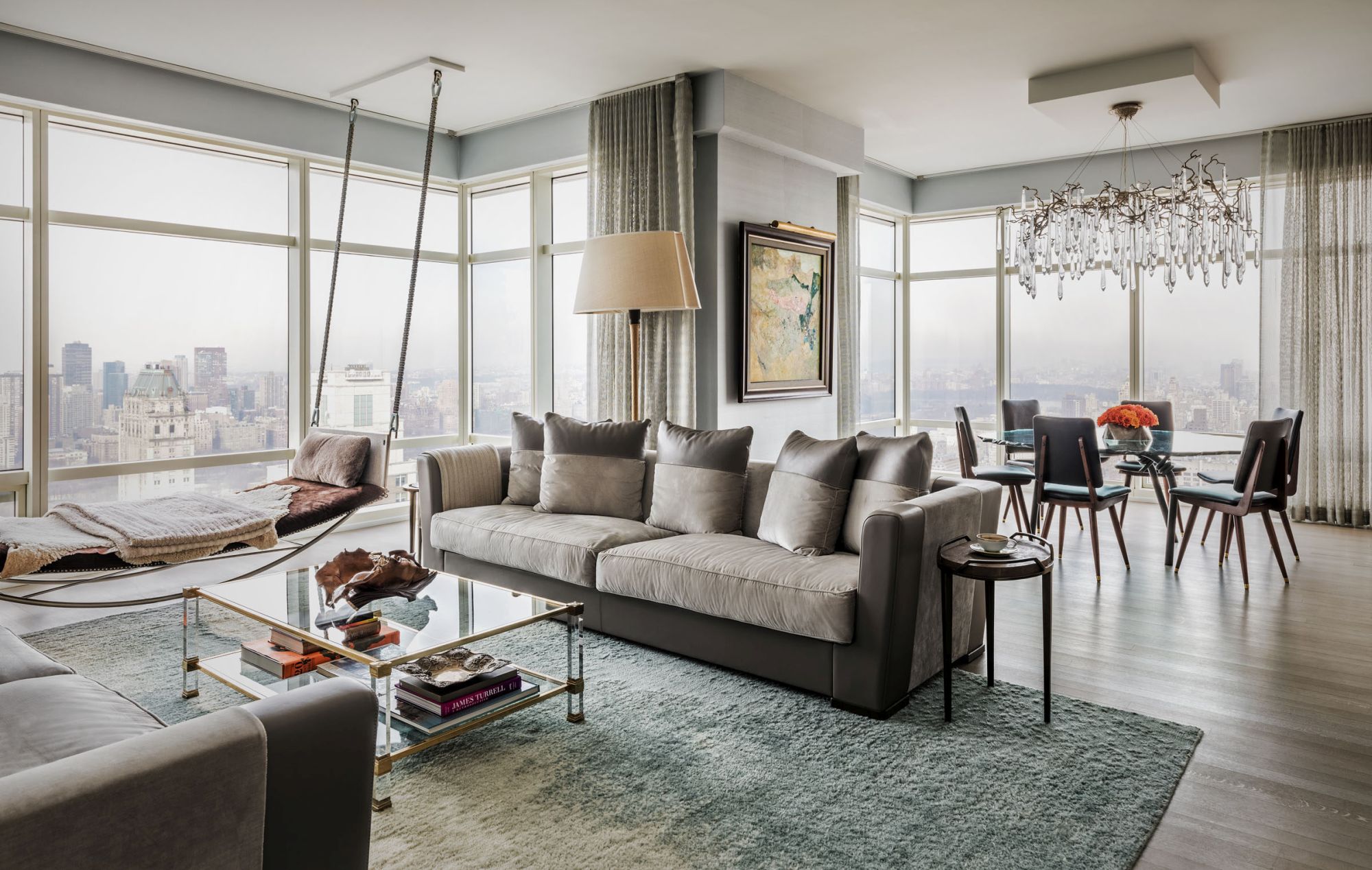
Out with Old in with the New - Pantone Colour of the Year
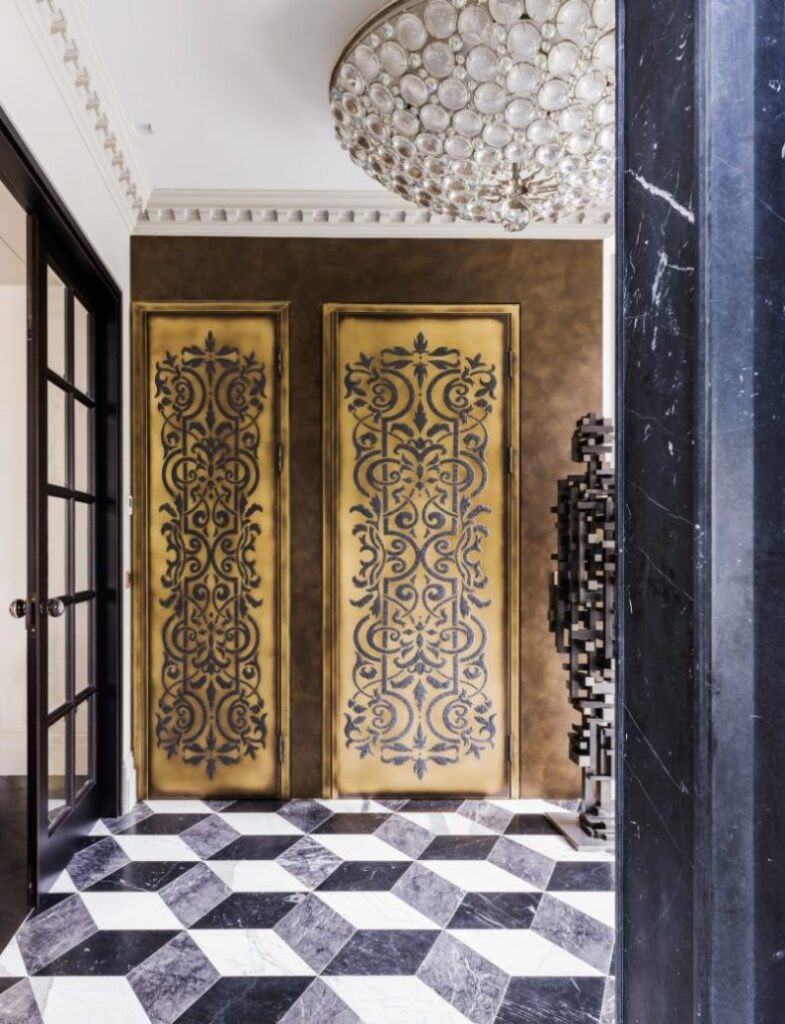
Hailed as the ‘symbol of the global zeitgeist of the moment and the transition we are going through’, the Pantone Colour of the Year 2022 is a dynamic blue with violet-red undertones. Very Peri, officially known as a PANTONE 17-3938, displays a ‘carefree curiosity’ and ‘daring curiosity’ that inspires creativity and vision.
Every 12 months, Pantone, the iconic provider of digital design solutions and colour standards, sets the tone for the year ahead with its Pantone Colour of the Year, and 2022 is no different. As we look to our surroundings for reassurance and inspiration, this year’s Very Peri provides the faithfulness and serenity of blue combined with the excitement and hubris of red. The result? An optimistic and empowering shade that reflects a new perspective and an ‘altered landscape of possibilities’.
A New Colour for a New Year
Interior designers, homeowners, and design enthusiasts look to Pantone to reflect our collective mood and each year, the design powerhouse shares its selection. In 2022, however, we really are being treated to something new. Pantone has created this year’s colour, Very Peri, from scratch, bringing us a brand-new shade at a time when we’re embracing a new world.
This is the first time that Pantone has launched a brand-new colour for its Colour of the Year educational program, and it is fitting that it’s for 2022. As we strive to find out place amidst an evolving landscape and we encounter new ways of living, Pantone’s fresh new colour gives us the confidence and reassurance we need to succeed.
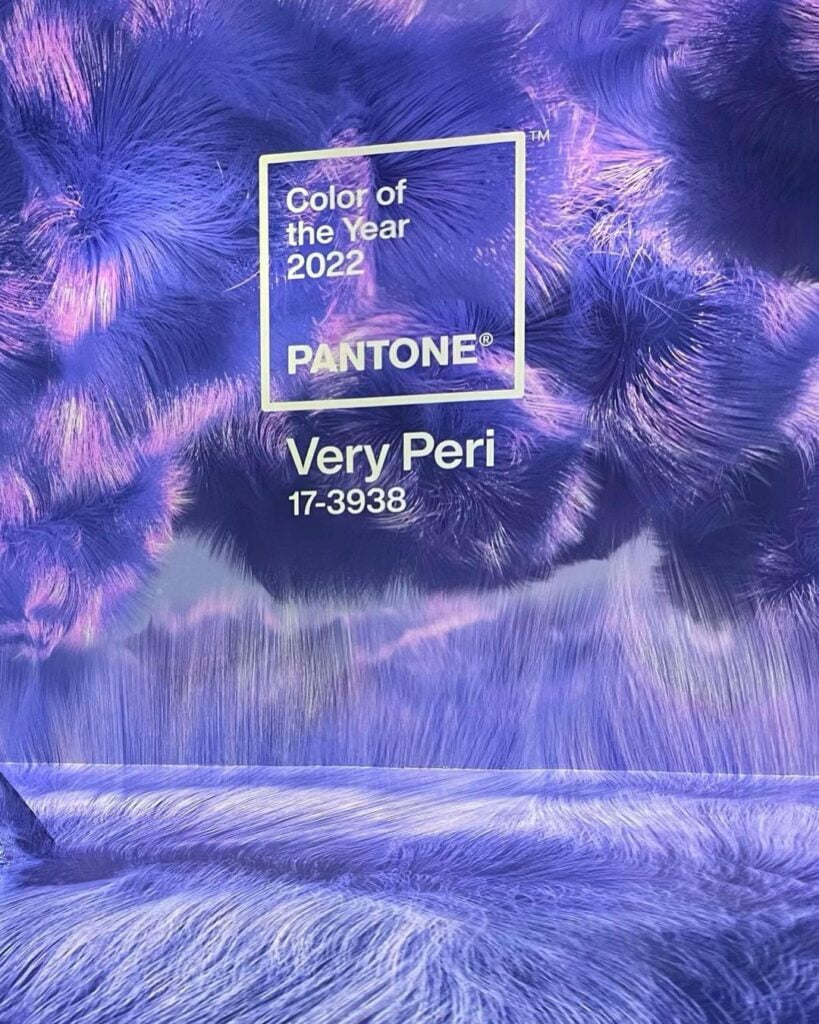
What is the Pantone Colour of the Year?
Now in its 23rd year, the Colour of the Year educational program highlights a colour that colour standards powerhouse, Pantone, believe will be widely used. Based on data-driven insights and trends, the Pantone Colour Institute takes a scientific and creative approach to arrive at their choice.
Pantone is, perhaps, best known for its Colour Matching System. Encompassing more than 2,100 different shades, Pantone effectively standardised these colours, so that printers and manufacturers could recreate the shade seamlessly, regardless of what equipment or processes were used. Since then, its Colour Matching System has also been ubiquitously online and in the world of digital design.
However, its Colour of the Year program has taken on a life of its own and its annual release is a key date in the diaries of interior designers, graphic designers, packaging designers, manufacturers, fashion designers and many other types of creatives. Running the gamut from digital art to physical objects, you’ll find that a wide range of artisans, designers and manufacturers incorporate this year’s Colour of the Year, Very Peri, into their work in 2022.
Pantone Colour of the Year in Interior Design
If you want to stay on-trend and use your surroundings to reflect the changing times, incorporating the Pantone Colour of the Year into your interior design is a savvy choice. Whether at home or work, you’ll find spaces that can benefit from the attributes of Pantone’s appointed shade and, as a result, you’ll be able to identify where and how to use Very Peri.
When it comes to interiors, Very Peri injects a ‘sense of playful freshness’, which can be maximised through ‘unusual combinations.’ Whether it’s in your living space, office or bedroom, the creativity and positivity associated with Very Peri will elevate the space and ensure your surroundings spark joy, fun and curiosity.
Incorporating Very Peri into Your Colour Palette
As well as releasing its Colour of the Year, Pantone helpfully publish suggested colour palettes to accompany their selected shade. If you’re looking for inspiration, this can be a useful way to discover which colour combinations can be used to maximise the impact you want to create.
If you want to blend Very Peri to create a natural, soothing palette with a hint of liveliness, for example, balance its confidence with Burnished Lilac, Lotus, Muted Clay, Dried Moss, Granite Green, Hawthorn Rose or Elderberry. A mixture of cool and warm tones, you can use Very Peri to enliven a tranquil space when you combine it with these stoical shades.
Alternatively, incorporate Very Peri into a palette of neutral classics and make it the ‘Star of the Show’ Amidst Anthracite, Volcanic Glass, Deep Taupe, Plaza Taupe, White Sand, Petrified Oak and Cloud Dancer, Very Peri is a ‘dynamic presence’ that adds a boldness to a timeless and classic palette.
When fun is a top priority, Very Peri works exceptionally well in conjunction with other joyful and whimsical shades. Tawny Orange, Pink Flambe, Iced Coffee, Fuchsia Pink, Paradise Pink, Cornsilk and Tourmaline harmonise well with Very Peri, elevating its vibrant playfulness without overpowering it.
For spaces where you want to mimic the outdoors and inspire wellness, add Very Peri to green-inspired shades. The quiet consistency of Chai Tea and Dewberry, in conjunction with the nature-infused shades of Treetops, Greenbriar, Foliage and Celery, and the lighter shades of Eggshell Blue and Very Peri, work effortlessly together to generate a holistic and nurturing colour palette that will revitalise and restore.
Where to Use the Pantone Colour of the Year
At first glance, Very Peri, might seem like a tricky colour to integrate into your existing colour scheme. However, the solid consistency of its blue hues and the spark of fun associated with its violet undertones make this a fantastic colour to have around you. What’s more – the range of colour palettes outlined above show just how easy it is to incorporate this innovative shade into any environment.
From a contemporary, open-plan living space or a snug den to a home office or a shared workspace, you’ll find that Very Peri has something to offer. Whether you choose to make the Pantone Colour of the Year your base colour or use it to add contrast and depth to an existing colour palette, the courage, creativity, imagination and optimism of Very Peri will nurture and embolden you as you embrace a new world and a modern era.
What does Monochromatic Mean in Interior Design?
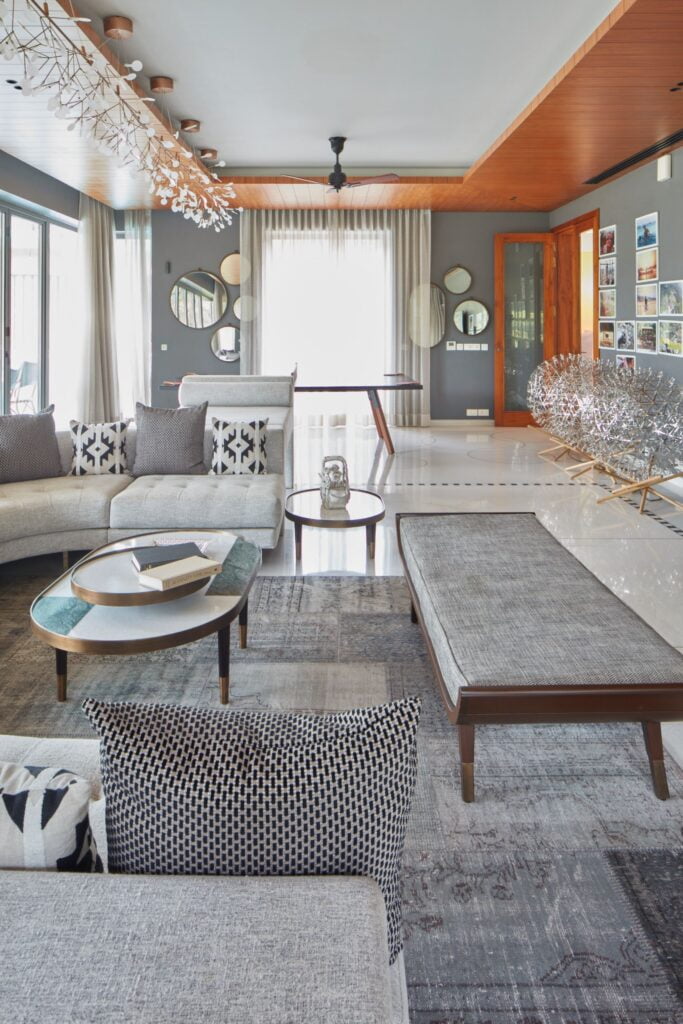
The term ‘monochromatic’ is often used in interior design and decorating, but what does it really mean? More importantly, how can you use monochromatic scheme interior design to create a revitalising living environment, an inspiring workspace, or a fun entertainment area?
In this post, we’re focusing on all things monochromatic – what it means within the world of interior design and how to use the concept to make the most of any space.
What is Monochromatic Interior Design?
The word ‘monochromatic’ literally means ‘one colour’, but this doesn’t necessarily mean using a single shade to decorate an entire room! Instead, monochromatic interior design typically refers to using different shades, tones, and tints to generate different hues, effectively broadening the impact of a single colour. If you want to use red to decorate a space, for example, you could use a range of shades from vibrant pinks, bold scarlet or dark maroon to add variation to the design.
Of course, using a single colour to decorate a room will inevitably mean that it overwhelms the space, but using variations of this colour can have the opposite effect. To find out more, take a look at these seven easy ways to apply monochromatic scheme interior design in your home or workspace:
1. Select Your Colour Palette
Once you know which colour you want to use as the basis of your monochromatic interior design, you can begin to experiment and select your colour palette. Here, you’ll have the opportunity to incorporate different shades, tones and tints into your interior design.
Whether you end up using two or 10 different shades to decorate a space, your colour palette will have a tremendous impact on the overall effect. Due to this, it’s well worth taking your time and trialling different hues before you make a final decision. After all, the natural light in the space, combined with the dimensions of the room and artificial lighting, can affect how a colour looks.
By giving yourself a blank canvas and seeing how different shades look in various areas of the room, you can finalise your monochromatic colour palette.
2. Create Visual Interest with Prints and Patterns
When you’re using a monochromatic interior design scheme, don’t limit yourself to using only blocks of colour. While a burst of block colour can be impactful when used sparingly, filling the room with large swathes of block colour will soon become dull. Instead, add visual interest by using prints and patterns in the tones, tints and shades of your colour pattern.
3. Add Depth with Different Textures
As well as using prints and patterns to create visual interest, you can add depth to a room simply by incorporating different textures into your interior design. Even a combination of sleek, glossy paint and a matt finish can be enough to increase the depth of a particular area and create a more polished finish. However, it doesn’t stop there.
When you’re selecting furniture, artwork, and decorative accessories for the space, be sure to incorporate different textures here too. By using varying textures, as well as choosing pieces that match your style, you can increase the depth of your design and create a space that’s visually exciting and appealing.
4. Don’t Get Hung Up on Black and White
Many people assume that ‘monochromatic’ means a black and white colour scheme, but this isn’t the case at all. While true black, carbon black, black red, graphite, deep grey, charcoal, and black olive could certainly make up a fabulous monochromatic interior design scheme, you needn’t feel restricted when it comes to which colour to use as the basis for your design. Instead, begin by choosing a colour you love in a particular space and use a colour chart to identify the varying shades, tones and tints that will work well within the design.
5. Use at Least Three Shades
When you’re using monochromatic scheme interior design, it can be tricky to decide just how many shades or hues to incorporate into one space. Ideally, you should aim for at least three shades to create a varied yet cohesive look. Selecting a dark, middle, and light shade gives you the opportunity to experiment with varying tones and tints while adding light and depth to the space.
Of course, you don’t have to limit yourself to just three shades either. If you want to add more hues to your colour palette, simply look for shades that share the same base colour and feature different tones.
6. Let Contrasting Shades Draw the Eye
Contrast is an important principle of visual communication. It can turn a simple accessory into a statement feature and will draw the eye to wherever you use it. Even when you’re using monochromatic scheme interior design, you can use contrast to differentiate between features in a room.
If you’re using blue as a base colour, you might have a deep blue sofa topped with cornflower cushions, for example. Alternatively, using a lime green with a forest green will contrast in the same way and allow you to use your monochromatic colour scheme to highlight features in any room.
7. Incorporate a Neutral Colour
A true monochromatic interior features just one colour in varying shades and tones but this can often be overwhelming. To add balance, incorporate a neutral shade to ‘break up’ the monochromatic colour. A white kitchen island can look fabulous amidst a monochromatic colour scheme, for example, while a dove grey armchair can be a great neutral option in a monochromatic room.
Using Monochromatic Interior Design At Home or Work
From soothing tones for relaxing spaces to vibrant hues for motivating environments, you can use colour theory to help you create the look and feel you’re after and, with these top tips, you’ve got everything you need to begin planning your very own monochromatic interior!
Interior Designer’s Guide to Beautiful Mirror Placement
Mirrors certainly play a functional role but their impact on interior design should never be underestimated. With the potential to add depth and brightness to any space, a mirror is a simple yet effective way to elevate a room.
If you want to create the best effect, however, it’s important to position mirrors in suitable locations. Whether you’re enhancing a hallway, kitchen, bedroom, or living area, mirror placement matters. To help you achieve the best results, take a look at these top interior designer’s tips for beautiful mirror placement:
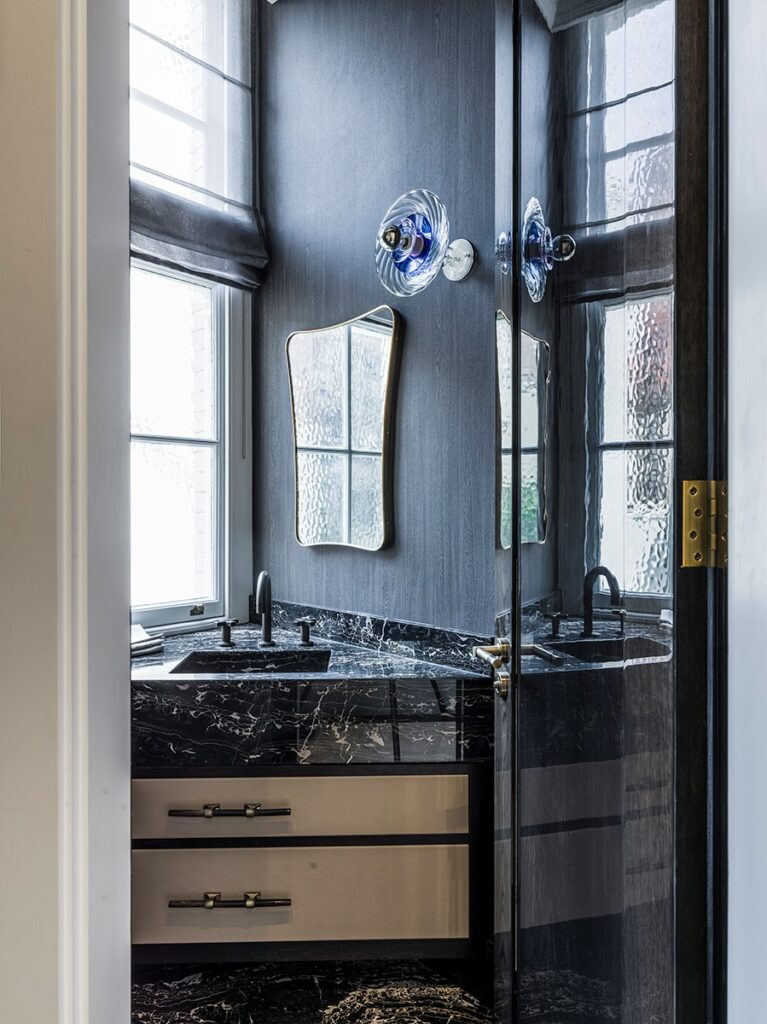
1. Hang Opposite or Next to Windows to Amplify Light
If you want to make a room feel brighter, hang mirrors in a location where they can reflect the natural light. Generally, hanging a mirror opposite a window will allow it to reflect the most light but placing a mirror next to a window will also capture and reflect a considerable amount of light too.
By using a mirror in this way, you can make the space feel lighter and brighter throughout the day. Even when the weather is overcast or the sun is nowhere to be found, whatever natural light is available will be amplified by your new mirrors.
2. Brighten a Space by Reflecting Artificial Light
Mirrors don’t only reflect natural sunlight, so don’t hesitate to use them to reflect artificial light too. If you’re designing the interior of a space that has few windows (or no windows) at all, use mirrors to maximise the amount of light in the room.
Placing a mirror close to a floor-standing lamp, wall light or even a desk lamp can have a big impact on how much light is created. What’s more – the mirror will diffuse the light and amplify it without creating a harsh or cold environment.
3. Create a Focal Point
A mirror can complement existing features, such as mantlepieces, but they can also be statement pieces in their own right. If you want to create a focal point in a room that’s lacking a centrepiece, use mirrors to draw people’s attention.
An ornate, carved mirror can be as impactful as a painting or sculpture, for example, while coloured mirrors can be fun and playful. If you don’t fancy hanging a large or oversized mirror, use smaller pieces to create a focal point on one wall.
4. Recreate Windows to Make Smaller Spaces Feel Larger
There are plenty of areas in a home that may not have windows to provide natural light, such as hallways or WCs. Hanging a mirror in these spaces can recreate the feel of a window and instantly make the room feel larger.
Additionally, if you want to blend one space into another, you can use a mirror to create this effect. If you have a partition wall that separates an otherwise open-plan space, for example, adding a mirror will make the room feel more unified.
When choosing a mirror for this purpose, you can even select a piece that recreates the size and shape of a small window. A circular, quarter arch or hexagonal mirror can easily give the appearance of light flowing through a window.
5. Experiment with Mirrored Art
Artwork can be a great addition to a home or workspace. With mirrored art, you can brighten and uplift a space while displaying impactful design. When combined with other materials, such as wood, metal, or coloured glass, a mirror can be a spectacular form of wall décor. With larger pieces, you can even create a captivating accent wall in high-impact areas, like hallways and foyers.
6. Use Black and Grey Mirrors to Create an Impact
When you’re using mirrors to enhance your interior design, you don’t need to rely solely on standard glass that offers a ‘mirror image’. In the same way that mirrored artwork can be an enthralling statement piece, dark coloured mirrors can have the same impact.
A black, grey, slate, or bronze mirror can add a touch of lightness to bold interiors and will complement a contemporary design perfectly. Paired with natural materials or an industrial interior, this modern styling will elevate the space and add depth to the space.
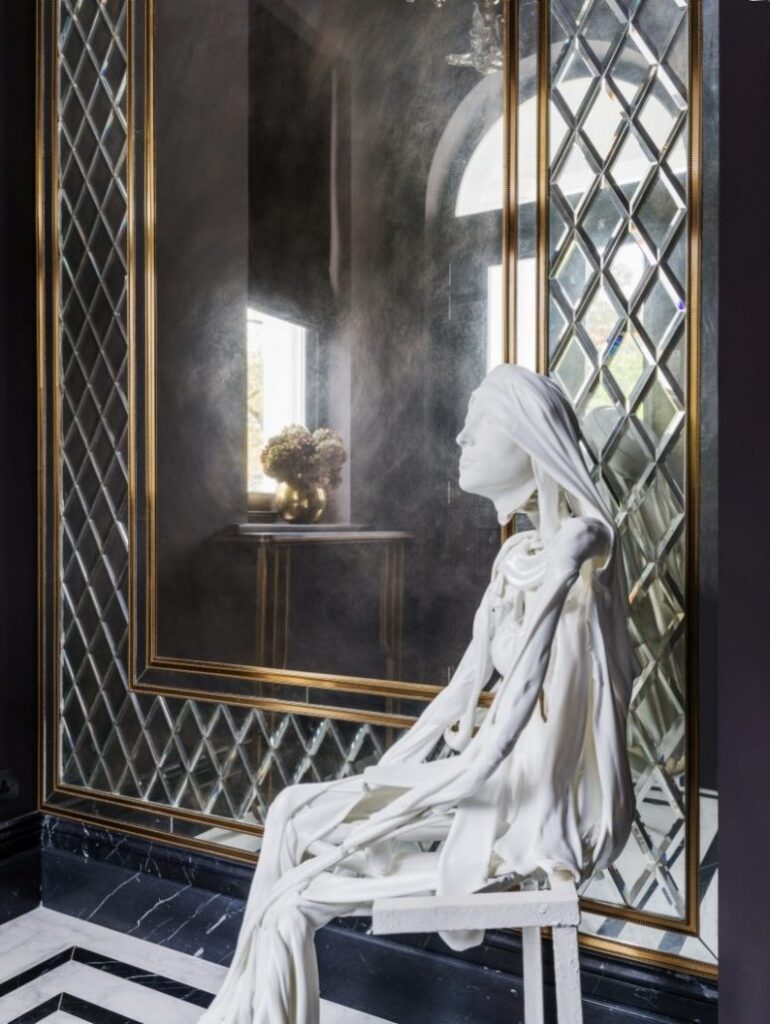
7. Hang Mirrors at the Right Height
Mirrors should typically be hung at eye level, which is usually around 57 – 65 inches from the floor. However, the perfect placement depends on exactly where your mirror will be situated and what surrounds it.
If you’re hanging a mirror above a piece of furniture, for example, the height of the furniture will have an impact on where the mirror should be hung. Ideally, you’ll want to leave a gap of at least four inches between the furniture beneath the mirror and the bottom edge of the mirror, as this provides a ‘visual break’ between the two pieces.
When you’re hanging mirrors above furniture, do make sure that leaving a gap between the pieces won’t result in the mirror being too high. Instead, opt for a small mirror that will create an impact without making the space feel overcrowded.
8. Lean Mirrors Instead of Hanging Them
If you never seem to get round to hanging new mirrors or artwork, there’s an easy alternative: lean them against walls or furniture instead! Not only will this ensure that you get to display your latest pieces without going to the trouble of hanging them, but it can also add a different effect.
The Best Faux Fur Throws and How To Style
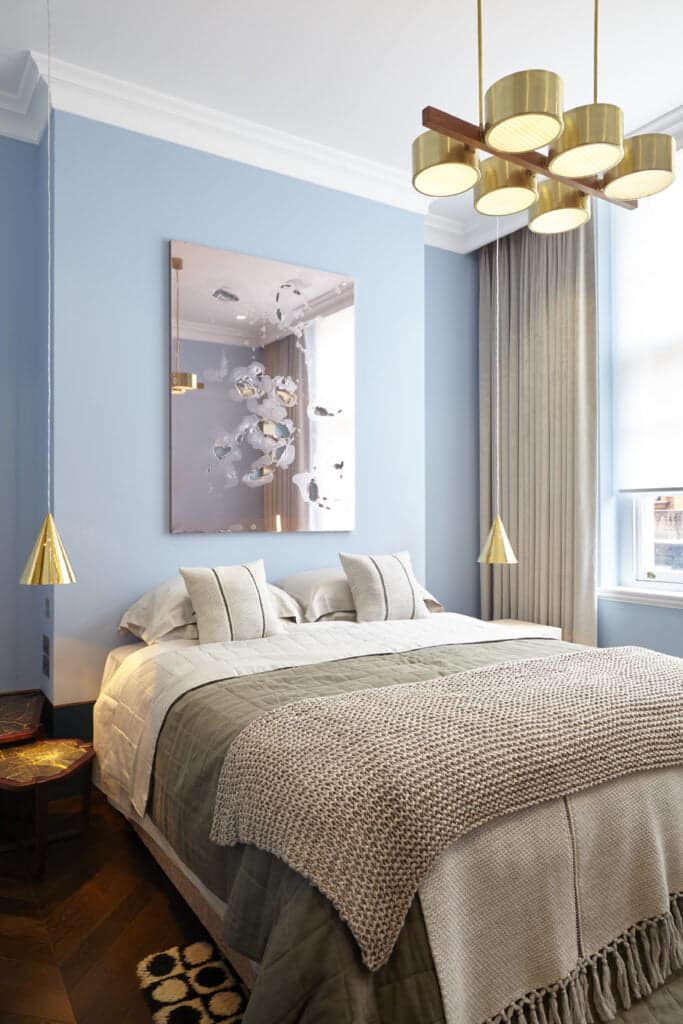
Blankets and throws are must-have home accessories, but faux fur undoubtedly adds a touch of luxury and cosiness to any interior. From snuggling up on the sofa to styling a bedroom, faux fur throws can transform any space into a warm, inviting retreat.
Of course, the benefits of faux fur aren’t limited to their soft finishes and visual appeal; they’re also a fabulous way to enhance your home while staying animal friendly. Offering all of the benefits of genuine fur with much more palatable origins, faux fur can be enjoyed by everyone.
To find the right accessories for your home this season, take a look at expert advice for finding the best faux fur throws out there and find out how to style them:
1. Use Faux Fur to Add Texture
As you might expect, faux fur instantly adds texture to any space. If an area feels a little lacking in personality or appears to be too neat and tidy, a faux fur throw will make it more relaxed and inviting. However, don’t make faux fur compete too much with other tactile fabrics or materials.
Texture adds visual weight to a room and too much can make the space feel crowded. Adding a large faux fur rug when you already have a decadent velvet sofa, silk cushions or wool blankets might be too much. Instead, stick to using faux fur when it can add balance to areas that are currently lacking in texture.
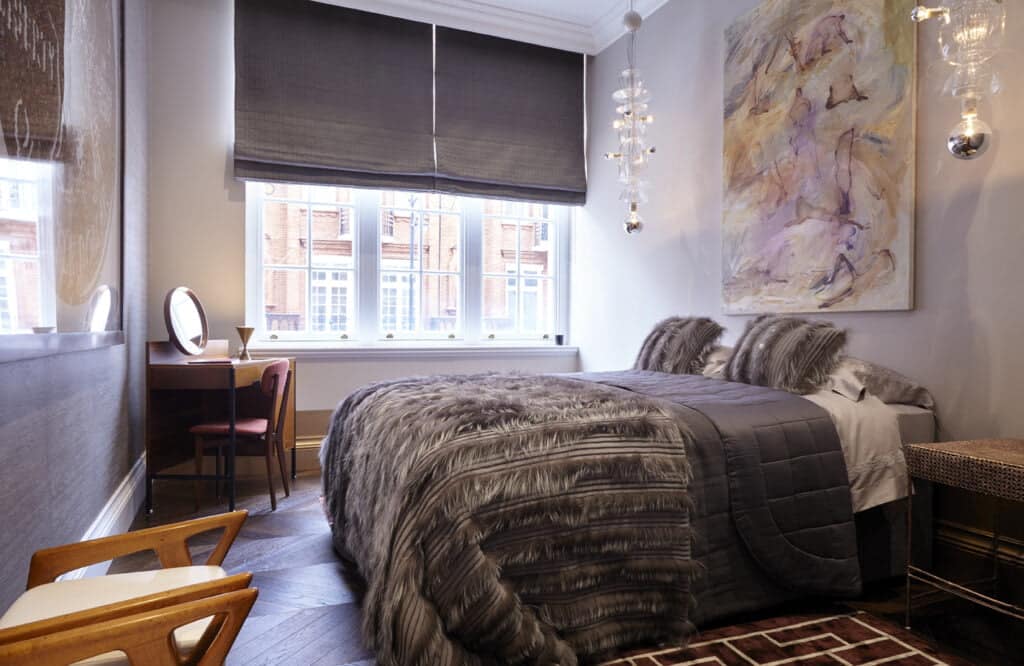
2. Choose Throws with Long Hair
If you want to recreate the look and feel of genuine fur, opt for faux fur throws or blankets with longer hair. This mimics the appearance of real fur but it also enhances the warmth and texture of the fabric. Whether you’re adding a throw to your interior design or choosing a faux fur cushion or rug, pieces with a long-haired finish will always look more realistic.
Similarly, it’s well worth doing your research before you select a new throw for your interior. Quality can vary when it comes to faux fur, so make sure that the piece you choose feels as good as it looks. Fortunately, there are many designers and artisans who are creating fabulous faux fur pieces right now.
3. Look for Tonal Variety
Genuine fur never comes in one, single, solitary shade, so your faux fur throw shouldn’t either. Instead, look for throws that have variations in the shade or tone. Even block colour throws can offer tonal variation, which will generate a more realistic appearance. As well as looking more like real fur, this tonal variety will increase the depth of the colour too and add even more texture to your interior.
Remember – if you want to recreate the appearance of real, undyed fur, choose colours that can naturally be found in the animal kingdom, such as browns, greys, creams, tans, taupe, deep reds, mahogany or off-white.
4. Complement Furniture with Faux Fur
When you’re adding a throw to an interior, beds and sofas are an obvious placement choice. However, these aren’t the only spaces that can be enhanced with the addition of faux fur. If you want to do something a little different, use faux fur to complement other types of furniture too.
Draping a throw across the back of a dining room chair or placing it on the end of a bench in a hallway can add visual weight and texture to these spaces too. Furthermore, the softness of the faux fur will add balance to contrasting materials, such as wooden chairs and benches, wire-backed chairs, or marble tabletops.
5. Make Faux-Fur a Year-Round Accessory
There’s no doubt that faux fur is a must-have during autumn and winter, but these aren’t the only times of year that it can add opulence to an interior. By incorporating faux fur throws into your interior design all year-round, you can maintain a feeling of warmth and decadence in your home.
If you want to ensure that your new faux fur throw will become a year-round accessory, choose a throw in a lighter shade, such as cream, taupe, tan, or light grey. These shades will be easier to style in the warmer spring and summer months, whereas darker shades are best suited to blustery autumn days and cold winter nights.
6. Use Faux Fur in Formal Spaces Too
Faux fur might seem like it’s most suited to living areas and bedrooms, but there’s no need to restrict the luxurious materials to these areas only. In fact, the softness and texture of faux fur mean it can be a great addition to more formal spaces.
When you style a faux fur throw in an office, dining room, study, or library, for example, it will soften the visual appearance of the space and make the room feel cosier. Additionally, being able to pull a faux fur throw around your shoulders will keep you warm when you’re working late into the night or curling up with a good book!
7. Remember – Less is More!
Although faux fur is a tantalising and tactile fabric that’s capable of elevating virtually any space, it shouldn’t be overused. When you’re deciding how to style faux fur or where to place your newest home accessory, be sure to take a strategic approach. Less is definitely more when it comes to faux fur, so don’t be tempted to fill your home with it. Instead, use it sparingly for the best effect and style just one or two pieces in any room.
Create a Cosy Atmosphere with Faux Fur
Now you know how to use faux fur throws to add warmth and cosiness to your interior, you can enhance your existing design with this fabulous material. Whether you favour a contemporary feel or a more traditional style, faux fur throws can add texture, visual weight, and balance. With expert styling and complementing accessories, a faux fur throw is an effortless way to perfect your interior design this season.
The Effect of Lighting Design on Health and Wellbeing
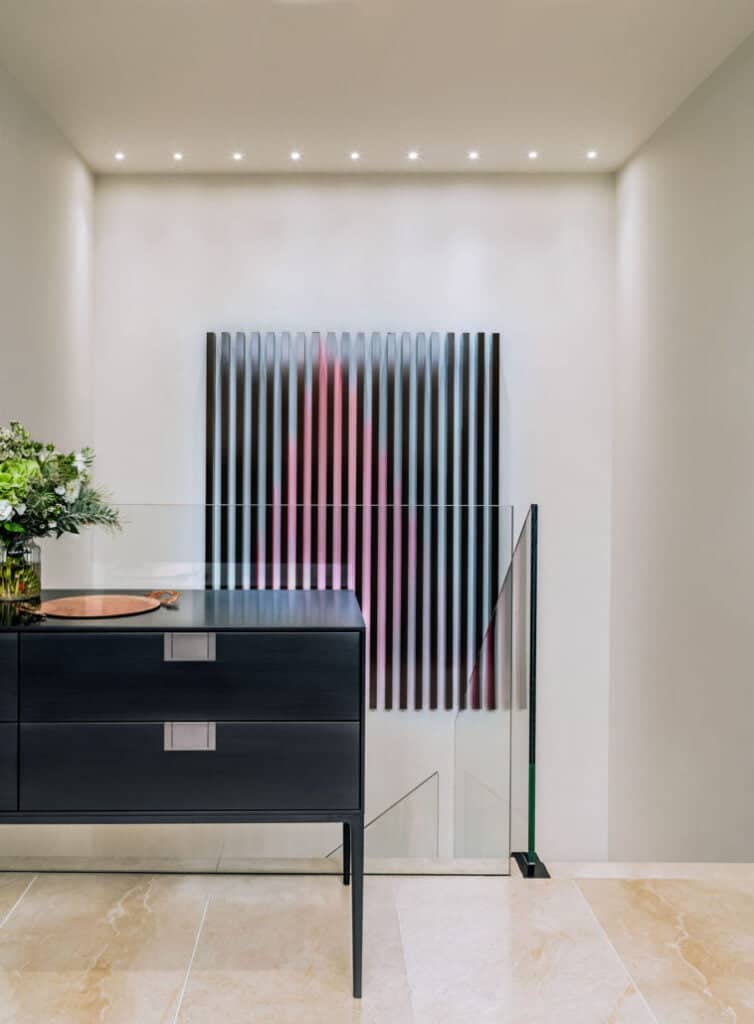
Lighting is a vital element in any interior design. Capable of making a space feel larger and brighter or more intimate and atmospheric, lighting can transform a room and enhance its purpose. However, this isn’t the only reason why lighting is a critical principle in every project Shalini Misra undertakes.
The impact of lighting on health and wellbeing has been well-documented, yet many people continue to overlook the effects it can have. By understanding the connection between lighting and wellbeing, you can ensure that your interior design nurtures and uplifts you, as well as elevating the aesthetic and function of your surroundings.
How Does Lighting Affect Wellbeing?
Our bodies are designed to respond to light, with natural processes automatically responding to the lighting stimulus we’re exposed to. The circadian rhythm – or sleep/wake cycle – relies on periods of light and darkness to regulate itself. That’s why getting up early on a bright summer’s day can feel easier than waking up on a dark winter’s morning!
We need exposure to natural light to produce vitamin D, which is essential for optimal health, so it’s not surprising that our bodies are intrinsically linked and highly affected by lighting. Of course, we don’t rely solely on natural lighting now that we have artificial lights at our disposal, but this doesn’t minimise its impact. In fact, it highlights why lighting design is so important to our wellbeing and why we need to use it to maximise our health wherever possible.
Lighting Can Intensify Emotions
When the brightness, hue, or saturation of light is increased, it can amplify the emotions we’re already feeling. Conversely, decreasing brightness, hue, and saturation levels can lessen the intensity of emotions. Similarly, cool lights can increase alertness and make it easier to focus, while warm lighting boosts relaxation.
If you’re feeling stressed or anxious, for example, unwinding in a dimly lit room can be more helpful than trying to relax in a bright space.
The effect of lighting on mood should be a decisive factor when using lighting design to elevate a space. If you’re designing a home office and want to be productive, efficient, and decisive, for example, cool, bright lighting can be advantageous. On the other hand, if you’re creating a relaxing den or soothing living space, muted lighting and soft glow lamps can offer the comforting and restful atmosphere you’re looking for.
Using Human-centric Lighting Design
To ensure your lighting design enhances health and wellbeing, it’s useful to take a human-centric approach. Essentially, this means being aware of the role that lighting has on the body’s natural circadian rhythm and using interior lighting to support this natural sleep-wake cycle.
By assessing how you use your space, you’ll find that it’s easy to take a human-centric approach to lighting design. If you have an open plan living space, for example, you may want to incorporate a variety of different lighting options to ensure that the versatility of the room is reflected. With brighter lights available for more active times, such as playing or working, and warmer, softer lighting on hand for restful evenings and relaxation, you can make sure that lighting is easily adjusted throughout the day to reflect the body’s natural cycles.
Alternatively, if you spend your working hours in a study and evenings in a den, you can incorporate cool, bright lights in your office space and warmer lighting in the den and living room and use the lighting design to reflect the purpose of the space.
Use Technology to Maximise Lighting Design
Technology is a fantastic way to optimise your lighting design, particularly as lighting designers are becoming increasingly aware of the impact light has on health and wellbeing. Now, health-enhancing lights, like SAD lamps for seasonal affective disorder or short-wavelength ‘blue’ lights for increased focus, are aesthetically pleasing, as well as functional.
Furthermore, the style of the lighting you choose can create a magical atmosphere in any space. From striking chandeliers to chic spotlights and slimline floor lamps to chunky table lamps, there are an array of lighting options that can be used in any environment.
How to Layer Lighting
If you want to get the most of your lighting design, both in terms of wellbeing and visual impact, a layered approach is beneficial. This increases the functionality of a room and allows you to modify the lighting based on the time of day, your activities, and your mood.
In its most basic form, layered lighting involves using multiple lighting sources to create a balanced environment. Instead of relying solely on ceiling lights, for example, you may choose to complement ceiling lighting with recessed lighting, wall lights, table lamps, and floor lamps.
By featuring lights at different heights, you can maximise their impact and versatility. Floor lamps and tabletop lighting allow you to modify the atmosphere in a room instantly and are easy to change or update in accordance with your overall interior design.
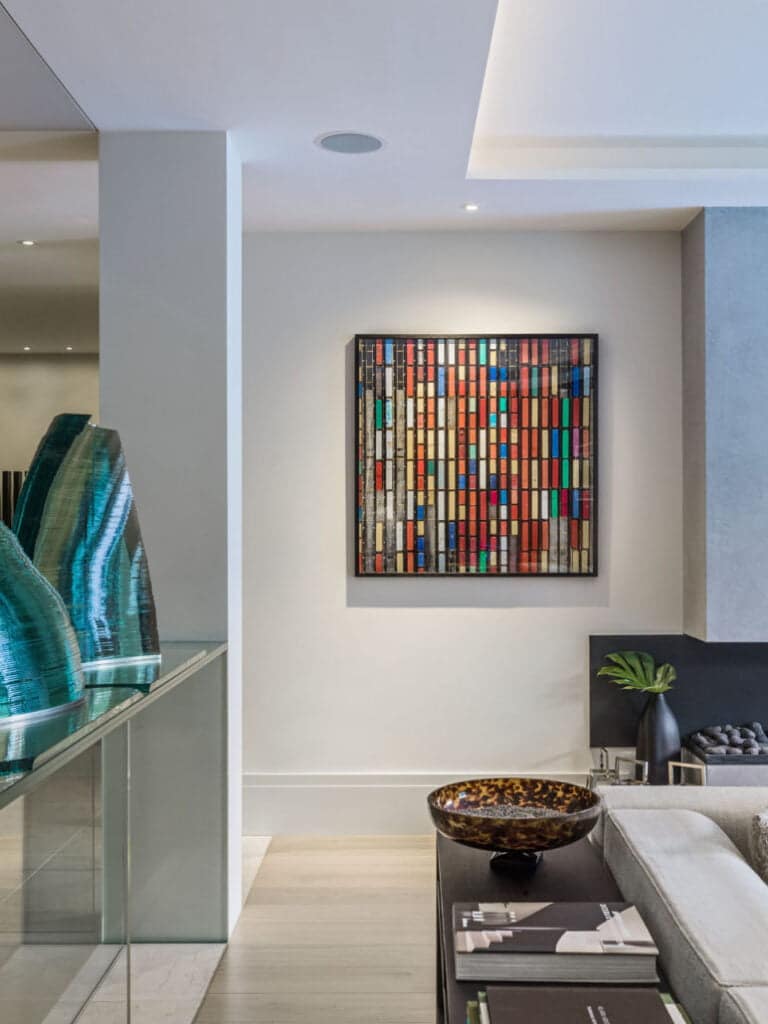
Showcase Your Interior with Lighting
As well as using lighting as a core element of your interior design, it can also be used to showcase particular aspects of the design or the interior as a whole. If you have statement pieces in a room, for example, be sure to use the right lighting to showcase them for maximum impact. Whether you want to draw attention to a stunning piece of art on the wall or a beloved sculpture in the hallway, discreet yet impactful lighting can be a subtle and effective way to highlight the aspects of your interior design that you enjoy the most.
Create Spaces That Maximise Wellness
Now you have had a glimpse into the integral role that lighting plays in any interior design, you’ll be able to incorporate lighting design into your own interiors more effectively. With a human-centric approach, you can maximise the critical role that lighting has on health and use it to optimise well-being – as well as using it to enhance the visual impact and aesthetic of your interior design.


